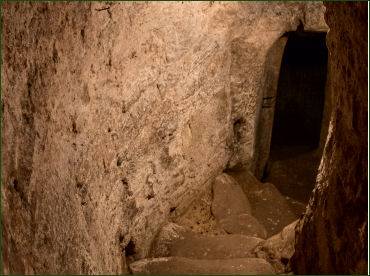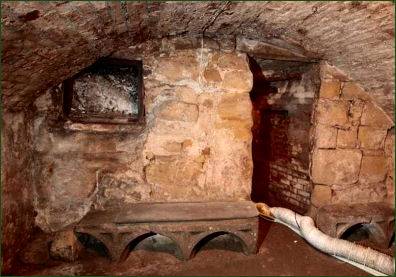Pontefract Hermitage
OS grid reference:-
Pontefract Hermitage, a grade I listed building, dates to the medieval era and is situated below the old Southgate entrance to the General Infirmary.
The unique structure consists of two chambers carved from the sandstone, which lay side by side but on different levels. From the lower chamber an amazing 63 step spiral staircase cut from the rock descends to a basin of water deep below street level. The upper chamber, of a later date, is known as the Oratory and measures 14 feet (4.25 metres) by 8 feet (2.45 metres) with a domed ceiling up to 8 feet high.


The Oratory contains an altar, a fireplace, a bench and low stool and a bed shelf. The entrance to the hermitage was protected by bolted doors. The entrances would have originally overlooked the Friarwood Valley towards St Richard's Friary further down the hillside.
Pontefract had hermits from the early thirteenth century, the earliest of whom, Peter of Pomfret, was executed by King John in 1213 for predicting his downfall. With discontent wide among the domestic nobility, some of whom were in contact with the wily King Philip Augustus of France, King Philip had already seized John's lands in Normandy and was gathering force to invade. Against this background, Peter prophesied that John's crown would pass to other hands by the next Ascension Day, which happened to be Thursday, May 23, 1213. A few days before that date, John, who had been placed under Inderdict by the Pope, made a submission to the papal legate Pandulf, as part of the deal, John offered to surrender the Kingdom of England to the papacy for a feudal service of 1,000 marks (equivalent to £666 at the time) annually: 700 marks (£466) for England and 300 marks (£200) for Ireland, as well as recompensing the church for revenue lost during the crisis. This story was dramatised in William Shakespeare's play King John.
The hermit tradition continued in Pontefract for around three centuries. The hermitage dates from 1386 after Robert de Laythorpe granted the then hermit, Brother Adam, the hermitage and accompanying land for life and it eventually it became the property of the monastery of St. Oswald at Nostell. It was discovered in October 1854 by workmen laying a new sewer.
The hermitage can be visited on scheduled open days.
